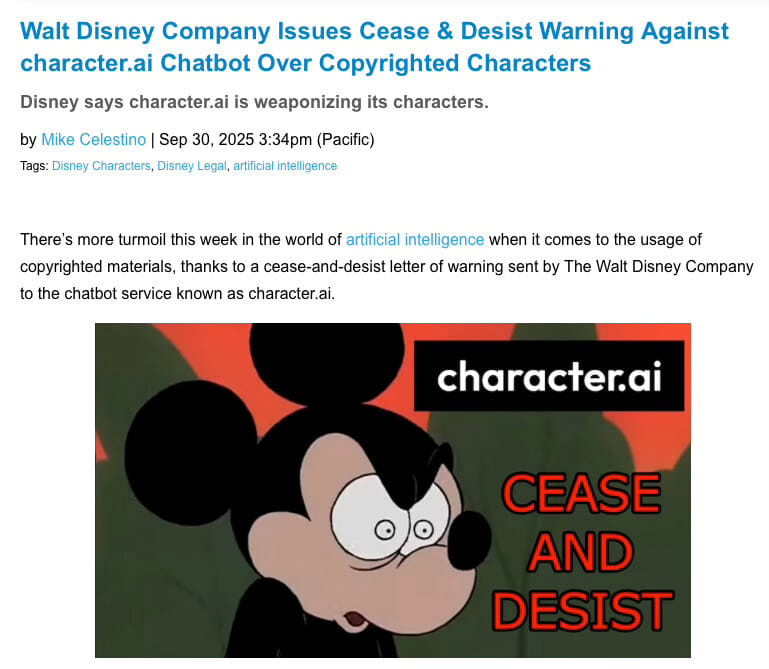- Pascal's Chatbot Q&As
- Posts
- Disney’s cease-and-desist against Character.AI is not an isolated skirmish but a blueprint for broader rights-owner strategies in the AI era.
Disney’s cease-and-desist against Character.AI is not an isolated skirmish but a blueprint for broader rights-owner strategies in the AI era.
Disney’s experiences show that rights owners must treat AI not simply as a copyright threat but as a reputational and cultural risk that requires immediate, coordinated, and multi-pronged responses.
Disney vs. Character.AI: A Turning Point for Rights Owners in the Age of Generative AI
by ChatGPT-4o
The Walt Disney Company’s recent cease-and-desist letter to Character.AI marks another significant escalation in the conflict between rights owners and AI platforms. The documents reveal Disney’s sharp rebuke of Character.AI’s unauthorized use of its characters—including those from Disney’s classic animation, Pixar, Marvel, and Star Wars—and its warning that such use not only infringes copyright and trademark rights, but also undermines the Disney brand’s integrity, particularly when AI chatbots generate inappropriate or exploitative outputs.
Key Elements of Disney’s Response
Framing the risk as reputational, not merely financial.
Disney underscored that AI’s impersonation of its characters can “weaponize” its intellectual property by corrupting their cultural meaning, especially when chatbots engage in sexual exploitation or manipulation of children. This shift highlights that the stakes are not just lost revenue, but the erosion of brand trust and goodwill.Targeting both copyright and trademark infringement.
Disney’s letter invokes both copyright law (unauthorized reproduction and exploitation of creative works) and trademark law (misrepresentation and brand dilution). By layering these legal frameworks, Disney strengthens its leverage.Positioning responsibility squarely on the AI platform.
Character.AI insisted its content is user-generated and removed characters upon notice. Disney, however, framed the responsibility as proactive: platforms must prevent misuse of rights at the source, not wait for complaints. This parallels legal precedents where platforms cannot shield themselves indefinitely behind “user-generated content” if they facilitate or monetize infringement.Escalation within a wider strategy.
The cease-and-desist fits into Disney’s broader legal offensive against AI firms. Recent suits against Midjourney (alongside NBCUniversal) and MiniMax (with NBCUniversal and Warner Bros. Discovery) show Hollywood aligning around coordinated enforcement.
Why This Matters Beyond Disney
Although Disney’s case centers on entertainment IP, the implications extend far beyond film and media. Other industries face similar threats as generative AI creates outputs that impersonate, exploit, or distort protected content.
1. Publishing and News Media
Risk: Generative AI tools may ingest and reproduce books, journal articles, or news reporting, undermining licensing revenues and diluting brand authority.
Relevance: Just as Disney stresses brand harm, publishers can argue that inaccurate or hallucinated outputs attributed to their brands damage trust in the “version of record.”
Response: Like Disney, publishers may combine copyright claims with trademark or unfair competition arguments to tackle reputational misuse.
2. Music and Recorded Media
Risk: AI “deepfakes” of famous musicians (e.g., Drake or Taylor Swift imitations) threaten both market value and brand perception.
Relevance: Disney’s stance against “sexual exploitation” of characters parallels musicians’ concerns over reputational harm if AI voices are used in offensive or political contexts.
Response: Record labels could emulate Disney’s aggressive cease-and-desist approach, highlighting both infringement and the moral rights of artists.
3. Gaming
Risk: AI tools can clone characters, artwork, or storylines from popular video games and insert them into interactive environments.
Relevance: Games rely on immersive character brands much like Disney franchises. Unauthorized AI integrations may distort their cultural meaning or expose minors to harmful content.
Response: Game studios can reinforce that user-generated disclaimers do not absolve platforms of liability—mirroring Disney’s rejection of Character.AI’s defense.
4. Sports and Fashion
Risk: Athlete likenesses and fashion brands may be replicated by AI for endorsements, merchandise, or adult-content deepfakes.
Relevance: Disney’s focus on brand “weaponization” applies here, as unauthorized use diminishes exclusivity and damages reputational control.
Response: Trademark law, publicity rights, and unfair competition doctrines offer strong tools, echoing Disney’s multi-layered legal framing.
Lessons for Other Rights Owners
Disney’s actions provide a template for industries grappling with AI’s disruptive potential:
Expand beyond copyright. Use trademark, publicity rights, and consumer protection laws to cover reputational and brand harms, not just lost licensing revenue.
Frame the argument around consumer trust. Disney highlighted the risk to children and families. Other industries should similarly emphasize public harm (e.g., misinformation in journalism, offensive misuses in music).
Demand proactive compliance. Rights owners should insist that AI firms filter out infringing content at the design level, rather than operate on reactive takedown models.
Form alliances. Disney’s coordination with NBCUniversal and Warner Bros. Discovery demonstrates the value of collective action—publishing, music, and sports sectors may likewise benefit from coalition lawsuits or licensing standards.
Balance litigation with licensing. Disney’s letter hints at openness to “partner with the industry.” Rights owners may leverage threats of enforcement into favorable licensing or revenue-sharing agreements.
Conclusion
Disney’s cease-and-desist against Character.AI is not an isolated skirmish but a blueprint for broader rights-owner strategies in the AI era. Its emphasis on reputational harm, proactive enforcement, and coalition action provides lessons for publishing, music, gaming, fashion, and beyond. For industries where trust and brand identity are as valuable as the content itself, Disney’s experiences show that rights owners must treat generative AI not simply as a copyright threat but as a reputational and cultural risk that requires immediate, coordinated, and multi-pronged responses.
